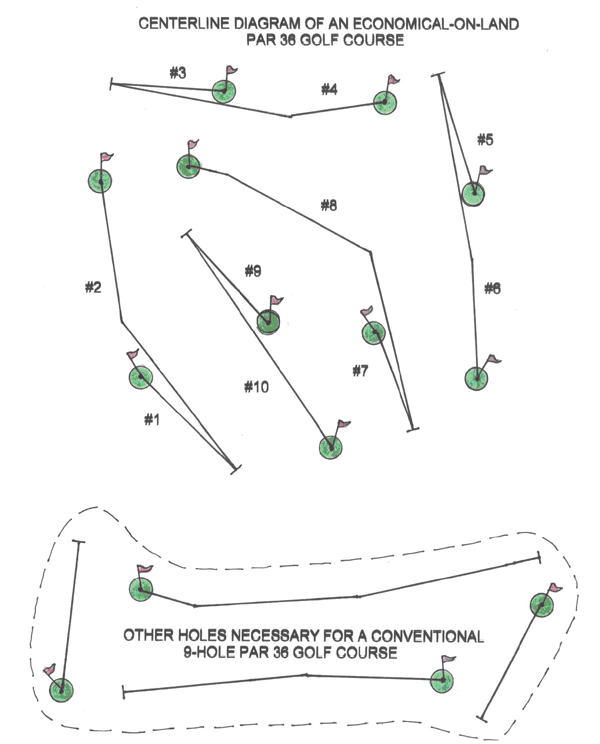
William W. Amick
ASGCA Golf Course Architect
|
|
|
|
|
|
|
HOW MUCH LAND TO BUILD A GOLF COURSE?
|
How much land is needed for a golf course? I can answer this question if I
know what kind of a course you want and the nature of the land. But what
if you don’t have quite enough land for the kind of nine or 18 holes you
desire? Should you forget the idea? Not necessarily. There is a way to
have challenging and full-length holes with a total par of 36 for nine
or 72 for 18. This is a course that significantly saves on the amount of
land compared to a conventional type golf course.
How is this accomplished? Mainly by having par 3 holes in the same areas for the par 4 and par 5 holes. Such an “economical-on-land” course would have holes something like this: Hole #1 a par 3 combined with the par 4 hole #2. Hole #3 a par 3 combined with the par 4 hole #4. Hole #5 a par 3 combined with the par 5 hole #6. Hole #7 a par 3 combined with the par 4 hole #8. Hole #9 a par 3 combined with the par 4 hole #10. Totaling a par of 36. And if the course has: Hole #11 a par 3 combined with the par 4 hole #12. Hole #13 a par 3 combined with the par 4 hole #14. Hole #15 a par 3 combined with the par 4 hole #16. Hole #17 a par 3 combined with the par 5 hole #18. Hole #19 a par 3 combined with the par 4 hole #20. Also totaling a par of 36 and together for a par of 72. Off each tee golfers will first hit their tee shot to a par 3 green and from the same tee then hit a drive beyond the par 3 green to the fairway of a par 4 or par 5 hole. They will putt out on the par 3 green, then go play out their drive on the par 4 or par 5. When following another group of golfers and the group ahead has putted out on the par 3 and gone to their drives, the group following can hit their tee shots to the par 3 green. After the group ahead has hit their second shots on the par 4 or par 5, then the group following can drive from the tee to the fairway of the par 4 or par 5 hole and finish playing the par 3 hole. This arrangement of greens, fairways and holes, plus procedure of play is not conventional. Despite with less land, it does allow a course to have excellent holes totaling a par of 36 or 72 using a slightly different procedure of play. Yet it will still require all the shots of any great course. The savings on land comes from not requiring the space for another par 4, one more par 5 and two par 3 holes, as would a conventional course with a par of 36. Or twice the number of those additional holes compared to for a regular par 72 course. And there will be fewer tees and fairways to maintain in the future. Golfers would adjust quickly to the relatively minor change in the playing procedure. They would understand they hit their tee shot to a par 3 green first and drive from the same tee to the fairway of the a par 4 or par 5 hole. And if they have to wait for a group ahead to complete play on that par 3 green or to hit a second shot on the par 4 or par 5 hole, they are already familiar with that courtesy. Here is a centerline diagram illustrating this less-land course. Naturally as for any golf course, its holes would have to be designed to fit the contours of that land and the shape of the boundaries of that property. At the bottom of this illustration, outlined with dashed lines, is a representation of the holes that would have to be included for giving a conventional type course a total par of 36.
If you have any questions about building a course like this, a conventional nine or 18-hole course or any type of golf course, simply email me at amick@iag.net or call for Bill at (+) 1 386 767 1449. I will be glad to answer questions and provide more information at no cost or obligation to you. |
|
|
| Professional Golf Course Designer - Bill Amick |
| P.O.
Box 1984 Daytona Beach, FL 32115 Telephone (386) 767-1449 |
| amick@iag.net |
